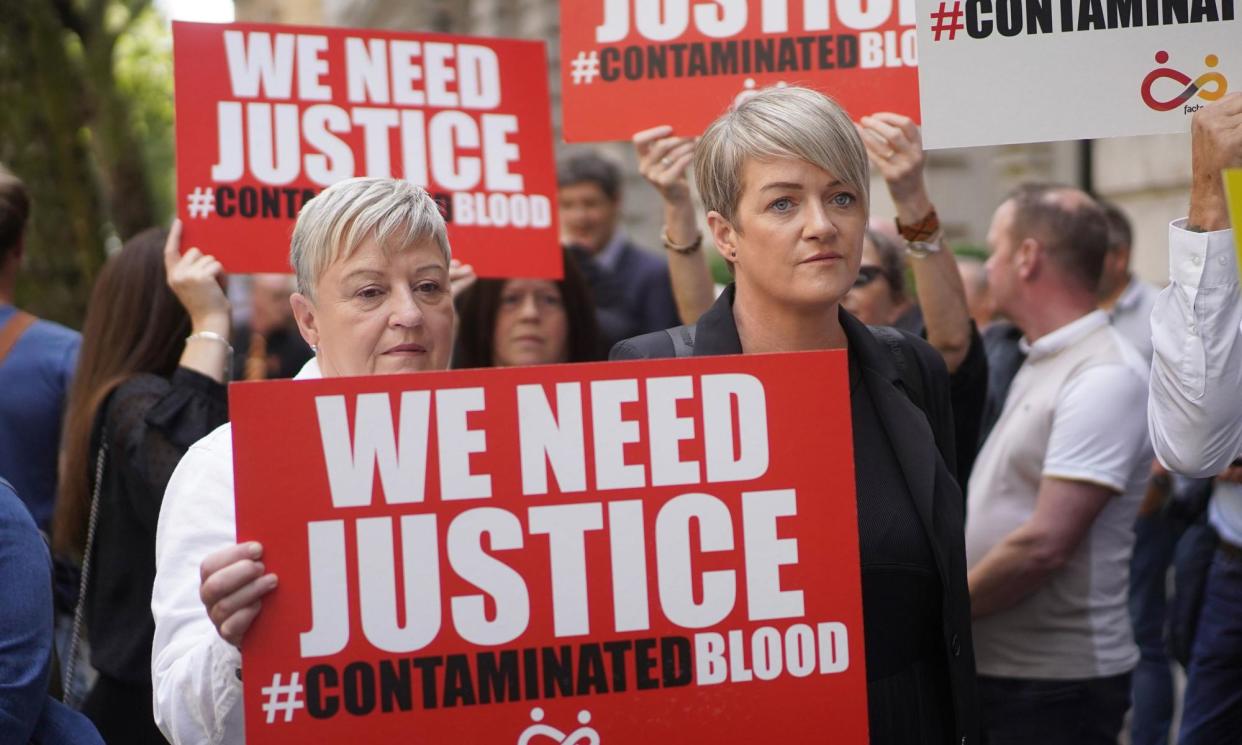Infected blood inquiry: study that said risk was seen as ‘tolerable’ omitted patient death

A study cited at the infected blood inquiry, as evidence that the devastating consequences of blood products contaminated with hepatitis could not have been foreseen, misrepresented the results of a trial in making its case, the Guardian can reveal.
Up to 6,520 people are believed to have been infected with hepatitis C through imported factor VIII blood products in the 1970s and 80s, while a further 26,800 are estimated to have been infected with the virus though blood transfusions. About 2,000 people are estimated to have died as a result.
The inquiry, which publishes its final report on 20 May, heard that the medical profession considered non-A and non-B hepatitis (later known as hepatitis C) as “relatively benign” at the time, with Pier Mannuccio Mannucci’s 2003 paper, Aids, hepatitis and haemophilia in the 1980s: memoirs from an insider, quoted in support of this proposition.
Mannucci’s 2003 paper argued that the view held by “the great majority of haemophilia treaters was that the problem of hepatitis was a tolerable one, because the benefits of concentrates seemed to outweigh risks”.
In making his argument, Mannucci cited his own work, writing: “A prospective biopsy study was undertaken by me … in 10 haemophiliacs with non-A, non-B chronic hepatitis followed up for more than six years. The study, published in 1982, demonstrated no case of progression towards cirrhosis or haepatocellular carcinoma.”
However, the original 1982 report says that there were actually 11 – not 10 – people included in the study and “one patient with active cirrhosis died of liver failure during the follow-up period”.
Who knew what about the risks and when is a key plank of the inquiry.
Jason Evans, who was four years old when his father died after receiving blood contaminated with HIV and hepatitis C and who founded the Factor 8 campaign, said: “It’s a calculated cover-up, removing the inconvenient truths about the lethal risks of hepatitis to justify the decision to give patients dangerous factor VIII blood products. We’re beginning to see the specifics of how the infected blood scandal cover-up happened, and the scale of it is genuinely incredible.
“This evidence exposes a dangerous precedent in medical research, where data was so easily manipulated to fit a narrative of defending past decisions.
“The audacity to omit a patient’s death to skew the results of a study is a direct assault on the scientific method and an abuse of the trust placed in researchers by the public. What happened here was not a mere oversight or a bad judgment call; it was clearly a deliberate act to deceive.
“The victims of this scandal deserve justice, and the medical community and the state must take the inquiry’s findings seriously to understand how it failed so many so profoundly.”
Mannucci’s 2003 study, which was published in the Journal of Thrombosis and Haemostasis, stated: “The view and arguments presented here are certainly not exciting for the media, which prefer stories about preventable disasters with their related blame on the medical community.”
Giving evidence at the infected blood inquiry in October 2020, Prof Christine Lee, who worked at the haemophilia centre for the Royal Free hospital in north London during the 1980s and 90s, quoted from the report, saying that “it was only in the mid-80s that it [hepatitis] was shown to be progressive and severe in one-sixth of patients”.
Lee told the inquiry that she did not like the idea of compensation for victims of the contaminated blood scandal because “it suggests liability” and people at the time “were doing what they thought was the best”.
Evans said that, given the 2003 study had misrepresented the data, it was “an abomination to the victims of the infected blood scandal” that Lee cited it.
Asked by the Guardian whether there was a cover-up, Mannucci, an emeritus professor of internal medicine at the University of Milan, said: “What happened with the 11th patient that developed severe liver disease and died with decompensated liver disease, frankly, I don’t remember. The majority of patients did not have liver disease, at least at biopsy, and these results were also confirmed by a much larger study done in the United States.
“Hepatitis C was not yet known. Only when hepatitis C was discovered much later, it became apparent that it could evolve to chronic liver disease and cirrhosis.”

 Yahoo News
Yahoo News 
